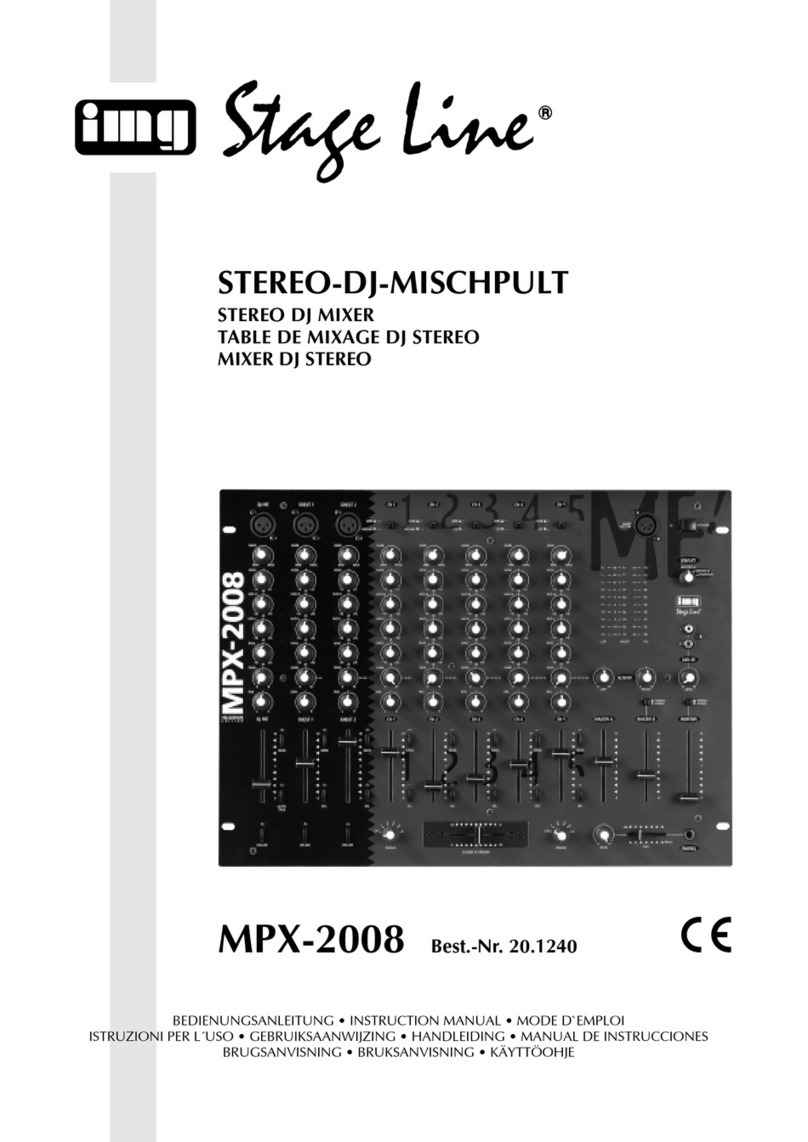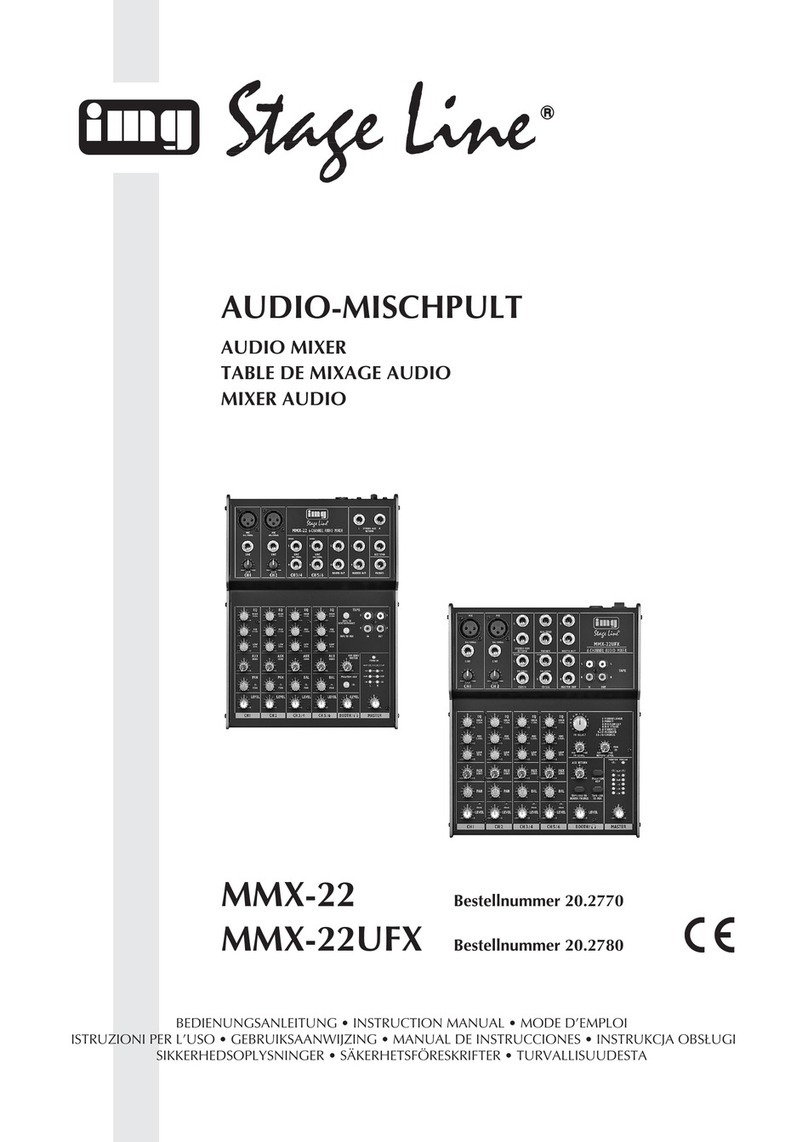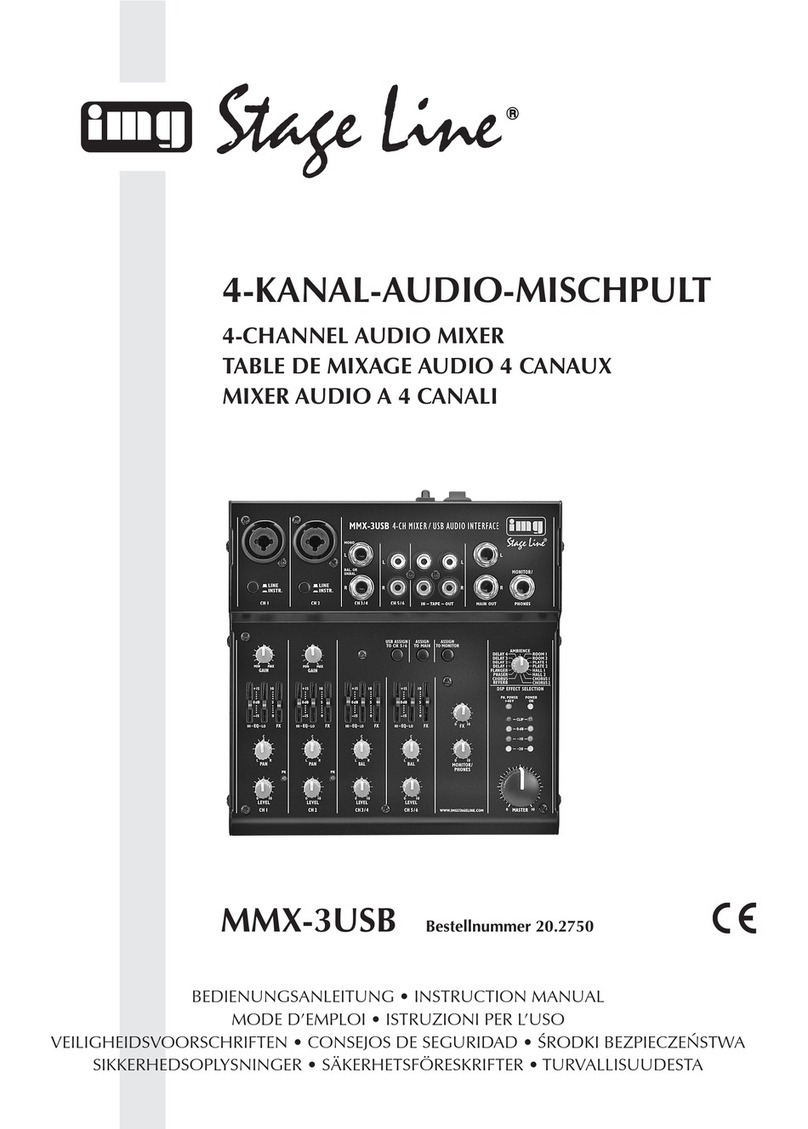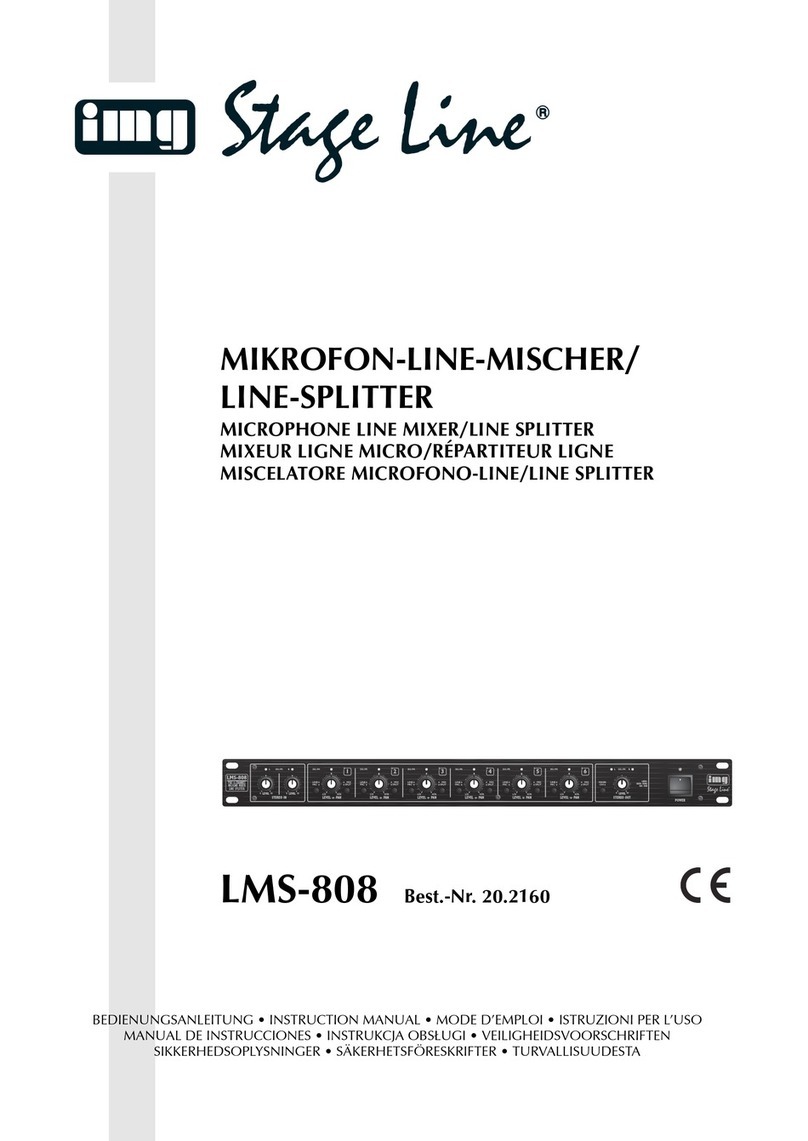5
D
A
CH
1.3 Ausgangsfeld
28 Fader AUX RET zum Mischen des Signals
am Eingang AUX RET (25) auf das Sum-
mensignal
29 Taste AFL mit Kontroll-LED zum Abhören des
Signals vom Eingang AUX RET (25) nach
dem Fader AUX RET (28) über einen an der
Buchse PHONES (19) angeschlossenen
Kopfhörer. Zum Anzeigen des Signals durch
die Pegelanzeige (43) muss auch die Taste
(42) unter der Anzeige hineingedrückt sein.
30 Taste MON EQ mit Kontroll-LED zum Ein-
schalten des Equalizers für das Signal des
Ausspielwegs AUX 1 zur Beschallung der
Musiker
31 7-Band-Equalizer für das Summensignal
32 7-Band-Equalizer für das Signal des Aus-
spielwegs AUX 1 zur Beschallung der Musi-
ker
33 Line-Ausgang MONITOR OUT (6,3-mm-
Klinkenbuchse, asym.) für das Signal des
Ausspielwegs AUX 1 zur Beschallung der
Musiker
34 XLR-Buchse LAMP zum Hineinstecken einer
Schwanenhalslampe für die Pultbeleuchtung
(12 V /500 mA max.)
35 Fader MONITOR für den Pegel des Monitor-
signals am Ausgang MONITOR OUT (33)
und für die Lautstärke des Monitorsignals,
wenn es auf die Endstufe gegeben wird
[Schalter AMPLIFIER ASSIGN (17) in der
mittleren Position]
36 Fader MAIN MIX für den Pegel des Sum-
mensignals am Ausgang MAIN OUT (45) und
für die Lautstärke des Summensignals, das
auf die Endstufe gegeben wird
37 Taste AFL mit Kontroll-LED zum Abhören
des Monitorsignals nach dem Fader MONI-
TOR (35) über einen an der Buchse
PHONES (19) angeschlossenen Kopfhörer.
Zum Anzeigen des Signals durch die Pegel-
anzeige (43) muss auch die Taste (42) unter
der Anzeige hineingedrückt sein.
38 Taste COMP/LIM mit Kontroll-LED zum Ein-
schalten des Kompressors für das Summen-
signal
39 Taste MAIN EQ mit Kontroll-LED zum Ein-
schalten des Equalizers für das Summen-
signal
40 Regler RATIO zum Einstellen des Kompres-
sionsverhältnisses
41 Regler THRESHOLD zum Einstellen des Ein-
satzpunktes (Schwellwert), ab dem das Sum-
mensignal komprimiert werden soll
42 Taste PFL/AFL – MAIN mit Kontroll-LED zur
Auswahl des Signals, das die Pegelanzeige
(43) anzeigen und das auf den Kopfhörer-
ausgang PHONES (19) gegeben werden soll
Taste ausgerastet:
Das Summensignal nach dem Fader MAIN
MIX (36) wird angezeigt und auf den Kopf-
hörerausgang gegeben.
Taste hineingedrückt:
Das Signal eines Kanals, dessen Taste
PFL (3) oder AFL (29, 37) gedrückt ist, wird
angezeigt und auf den Kopfhörerausgang
gegeben.
43 Pegelanzeige; zeigt den Pegel des Signals
an, das zum Abhören über den Kopfhörer-
ausgang PHONES (19) gewählt ist, siehe
Position 42
44 Betriebsanzeige POWER
45 Line-Ausgang MAIN OUT für das Summen-
signal (6,3-mm-Klinkenbuchsen, sym.)
1.4 Rückseite
46 Netzbuchse zum Anschluss an eine Steck-
dose (230 V~/50 Hz) über das beiliegende
Netzkabel
47 Halterung für die Netzsicherung
Eine geschmolzene Sicherung nur durch
eine gleichen Typs ersetzen.
48 Ein-/Ausschalter POWER
49 Lautsprecherbuchsen (6,3-mm-Klinke)
alternativ zu den Anschlüssen (50)
50 Lautsprecherbuchsen (SPEAKON®-kompati-
bel) alternativ zu den 6,3-mm-Klinkenbuch-
sen (49)
2 Hinweise für den
sicheren Gebrauch
Das Gerät entspricht allen relevanten Richtlinien
der EU und ist deshalb mit gekennzeichnet.
Beachten Sie auch unbedingt folgende Punkte:
GVerwenden Sie das Gerät nur im Innenbereich
und schützen Sie es vor Tropf- und Spritzwas-
ser, hoher Luftfeuchtigkeit und Hitze (zulässi-
ger Einsatztemperaturbereich 0 – 40 °C).
GStellen Sie keine mit Flüssigkeit gefüllten Ge-
fäße z. B. Trinkgläser, auf das Gerät.
GDie in dem Gerät entstehende Wärme muss
durch Luftzirkulation abgegeben werden.
Decken Sie darum die Lüftungsöffnungen des
Gehäuses nicht ab.
GNehmen Sie das Gerät nicht in Betrieb und
ziehen Sie sofort den Netzstecker aus der
Steckdose,
1. wenn sichtbare Schäden am Gerät oder am
Netzkabel vorhanden sind,
2. wenn nach einem Sturz oder Ähnlichem der
Verdacht auf einen Defekt besteht,
3. wenn Funktionsstörungen auftreten.
Geben Sie das Gerät in jedem Fall zur Repa-
ratur in eine Fachwerkstatt.
G
Ziehen Sie den Netzstecker nie am Kabel aus
der Steckdose, fassen Sie immer am Stecker
an.
GVerwenden Sie für die Reinigung nur ein tro-
ckenes, weiches Tuch, niemals Wasser oder
Chemikalien.
GWird das Gerät zweckentfremdet, nicht richtig
angeschlossen, falsch bedient oder nicht fach-
gerecht repariert, kann keine Haftung für
daraus resultierende Sach- oder Personen-
schäden und keine Garantie für das Gerät
übernommen werden.
3 Einsatzmöglichkeiten
Dieses Audio-Mischpult mit integrierter Stereo-
Endstufe (Klasse D, 2 × 400 WRMS an 4-Ω-Laut-
sprechern) ist für vielfältige Beschallungs- und
Aufnahmezwecke geeignet. Es ist als Tischgerät
ausgelegt und verfügt über 6 Mono- und 3 Ste-
reo-Eingangskanäle zum Anschluss von Mikro-
fonen (auch phantomgespeisten) und Tonquel-
len mit Line-Ausgangspegel (z. B. Instrumente,
Abspielgeräte). Ein weiterer Stereo-Eingangska-
nal kann z. B. für die Wiedergabe eines Aufnah-
megerätes genutzt werden.
Die Eingangssignale lassen sich auf einen
Stereo-Summenkanal und auf zwei Ausspiel-
wege mischen. Zum Zumischen von Effekten ist
ein digitaler Effektprozessor vorhanden. Die
Tonmischung lässt sich über einen Kopfhörer
abhören. Außerdem können einzelne Kanalsig-
nale über den Kopfhörer vorgehört werden.
4 Geräte anschließen
Um Störgeräusche zu vermeiden, vor dem Her-
stellen/Trennen von Verbindungen das Misch-
pult ausschalten oder die Fader MONITOR (35)
und MAIN MIX (36) ganz zuziehen sowie den
Regler PHONES (15) ganz zudrehen.
4.1 Tonquellen
In den Eingangskanälen kann nicht zwischen dem
Mikrofoneingang (13) und dem Line-Eingang
(11, 12) umgeschaltet werden. Darum pro Kanal
nur einen von beiden Eingängen anschließen.
4.1.1 Mikrofone
Mikrofone an die symmetrisch beschalteten
XLR-Buchsen MIC (13) anschließen. Für phan-
tomgespeiste Mikrofone lässt sich für jeweils
drei Mikrofoneingänge mit den Schaltern PHAN-
TOM (14) eine 48-V-Phantomspeisung einschal-
ten. Bei aktivierter Phantomspeisung leuchtet
die LED neben dem Schalter.
4.1.2 Line-Tonquellen
Tonquellen mit Line-Signalpegel (z. B. Empfän-
ger von drahtlosen Mikrofonsystemen, Effektge-
räte, Instrumente, Abspielgeräte) an die 6,3-mm-
Klinkenbuchsen LINE IN (11, 12) der Eingangs-
kanäle anschließen. Die Buchsen sind symme-
trisch beschaltet. Es lassen sich aber auch Gerä-
te mit asymmetrisch beschaltetem Ausgang über
zweipolige Klinkenstecker anschließen.
—Mono-Geräte an die Buchsen (12) der Mono-
Kanäle CH 1 bis CH 6 anschließen.
—Stereo-Geräte an die Buchsen (11) der Ste-
reo-Kanäle CH 7-8, CH 9-10 und CH 11-12
anschließen. Soll an einen Stereo-Kanal ein
Mono-Gerät angeschlossen werden, nur die
obere Buchse L (MONO) verwenden. Das
Mono-Signal wird dann intern auf den rech-
ten und linken Kanal geleitet.
Reichen die Eingangskanäle nicht aus, können
zum Anschluss von zusätzlichen Line-Quellen
auch folgende Stereo-Eingänge genutzt werden:
1. der Eingang AUX RET (25)
Beim Anschluss eines Mono-Geräts nur die
Buchse L (MONO) verwenden, das Mono-
Signal wird dann intern auf den linken und
rechten Kanal geleitet.
2. der Eingang TAPE IN (18)
z. B. zum Anschluss eines CD-Spielers für
Hintergrundmusik in den Spielpausen
Vorsicht: Bei eingeschalteter Phantomspei-
sung darf kein Mikrofon mit asymmetrischem
Ausgang angeschlossen sein, da dieses be-
schädigt werden kann.
Um Schaltgeräusche in den Lautsprechern und
im Kopfhörer zu vermeiden, die Phantomspei-
sung nur ein- oder ausschalten, wenn das
Mischpult ausgeschaltet ist oder die zugehöri-
gen Tasten MUTE (4) hineingedrückt sind und
der Regler PHONES (15) zugedreht ist.
Soll das Gerät endgültig aus dem
Betrieb genommen werden, übergeben
Sie es zur umweltgerechten Entsor-
gung einem örtlichen Recyclingbetrieb.
WARNUNG Dieses Gerät wird mit lebensge-
fährlicher Netzspannung versorgt.
Nehmen Sie deshalb nie selbst
Eingriffe am Gerät vor und stecken
Sie nichts durch die Lüftungsöff-
nungen. Es besteht die Gefahr
eines elektrischen Schlages.




































